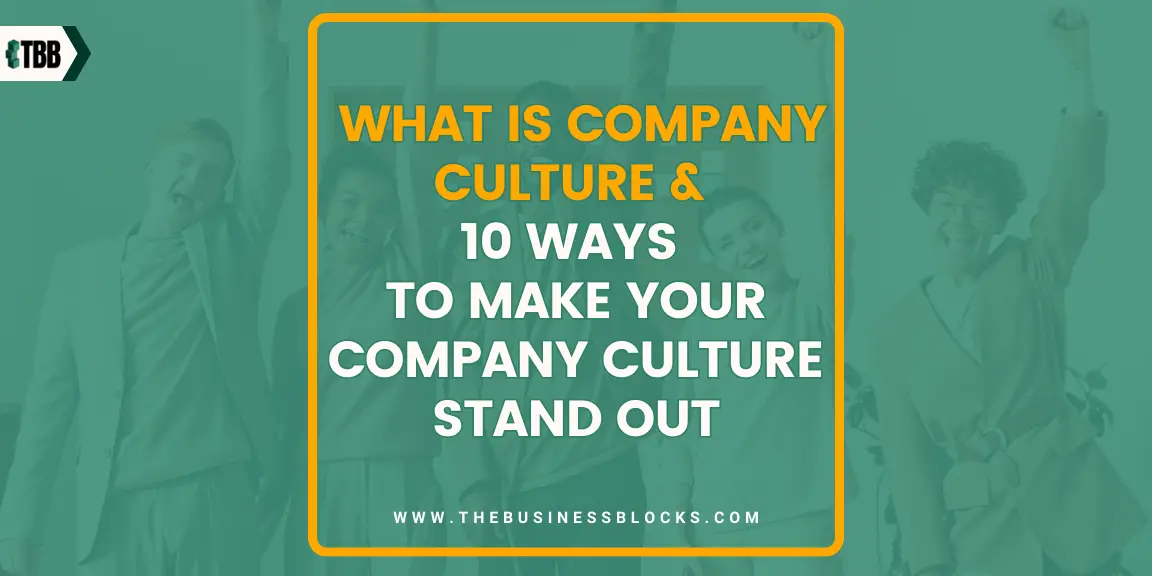A strong company culture is essential for success in today’s fast-paced business environment. A positive, inclusive culture can help attract and retain top talent, increase productivity and profitability, and differentiate your company from competitors. But with so many companies vying for attention, how can you make your company culture stand out?
Are you Looking to Create a Culture that Stands out from The Crowd?
Capturing the attention of future employees and building loyalty among current ones requires something special. Ways to Make Your Company Culture Stand Out offers definitive advice on staying ahead of the curve. This guide will provide a step-by-step plan for creating an engaging corporate culture based on stories and interviews with successful business owners.
Our comprehensive guide gives readers the tools they need to increase employee motivation, boost customer engagement, and stand toe-to-toe alongside competitors. Readers can build their unique company culture through detailed instruction to set them apart in any field. Implementing these strategies can help companies unlock hidden potential, grow productivity, and foster happier workplace environments.
What is Company Culture, and Why is it Important?

Company culture is the personality, values, beliefs, and attitudes of a company. It defines how employees interact with each other and the outside world and shape their overall experience at work. Company culture has an immense impact on employee engagement, productivity, creativity, and morale. An influence company culture encourages trust, loyalty, and respect between workers while motivating them to do their best. It also helps reduce stress levels, improve job satisfaction, and create a more enjoyable working environment.
Company culture is also essential for developing a strong brand identity and creating a positive public image. People naturally associate their experiences with a company – whether good or bad – and this can impact the business’s overall reputation. Organizations that invest in building a strong and positive company culture often find themselves with more customers, better customer loyalty, higher rates of engagement, and improved financial business success.
Here are the Different Types of Company Culture
- Hierarchy Culture: In a hierarchy culture, employees are organized into distinct roles and have clear responsibilities based on their roles. This environment is often found in larger corporations where authority and control are paramount.
- Market Culture: Market cultures focus on responding quickly to the ever-changing market and customer needs. This culture rewards innovativeness and collaboration, emphasizing agility and flexibility over structure.
- Clan Culture: Clan cultures are based on strong employee relationships and prioritize teamwork, collaboration, and shared values over individual success. This type of culture is often found in small businesses and start-ups.
- Adhocracy Culture: Adhocracy cultures emphasize creativity, exploration, and innovation. This environment rewards taking risks and encourages employees to think outside the box.
These are just a few examples of the different types of company culture. Every organization is unique and will have its own set of company values, beliefs, and attitudes that shape the working environment.
10 Ways to Make Your Company Culture Stand Out

When it comes to company culture, there are many ways in which you can make your business stand out from the crowd. Here are 10 ideas for making your company culture unique and effective:
1. Define Your Values and the Company’s Mission
To build a strong culture, you need a clear sense of purpose. Define your company’s culture, core values, and mission statement, and ensure they’re communicated to all employees. Your values should be more than words on a page; they should guide decision-making, behavior, and interactions with customers and colleagues. Living your values will create an authentic and aligned culture with your goals.
2. Foster Employee Engagement
Engaged employees are more productive, innovative, and committed to their work. To create a culture of engagement, encourage employees to share their ideas and feedback, recognize their achievements, and offer opportunities for growth and development. Provide regular communication and training, and create a collaborative, supportive environment that encourages teamwork and mutual respect.
3. Emphasize Work-Life Balance
In today’s hyper-connected world, it’s easy for work to spill over into personal time. However, employees who feel overworked and stressed are less productive and more likely to burn out. To create a culture that values work-life balance, offer flexible schedules, telecommuting options, and paid time off. Encourage employees to take breaks, prioritize their well-being, and model healthy company culture work habits yourself.
4. Celebrate Diversity and Inclusion
Diversity and inclusion are crucial components of a strong company culture. A diverse workforce brings a range of perspectives and experiences that can spark creativity and innovation. To create a culture that celebrates diversity, offers diversity training, recruits from diverse talent pools, and ensures all employees feel valued and respected. Foster a culture of inclusivity by addressing bias and discrimination and promoting equity and accessibility.
5. Encourage Open Communication
According to a Harvard Business Review, effective communication is essential for building trust and collaboration. Encourage open, honest communication among employees and between employees and management. Create channels for feedback and dialogue, and respond promptly and transparently to concerns and questions. Cultivate a culture of listening, empathy, and understanding, and ensure that everyone’s voice is heard and valued.
6. Reward and Recognize Performance
Recognizing and rewarding top performers is a key element of a successful culture. Acknowledge individual and team achievements with tangible rewards such as bonuses, promotions, or public recognition. Celebrate milestones and accomplishments, and encourage healthy competition and collaboration. By incentivizing excellence, you’ll create a culture of achievement and motivation.
7. Create a Positive Physical Environment
Your physical workspace can have a significant impact on your company culture. Create an environment that’s comfortable, safe, and inspiring. Incorporate elements that reflect your company’s personality and values, such as artwork, colors, or furniture. Provide amenities that promote well-being, such as healthy snacks, exercise equipment, or relaxation spaces. Creating a welcoming space and avoiding dysfunctional company culture foster a culture conducive to productivity and creativity. In exploring the dynamics of a vibrant company culture, the pivotal role of company secretary becomes evident in shaping an environment conducive to productivity and harmony among employees.
8. Encourage Volunteerism and Social Responsibility
Many employees value companies that give back to their communities and demonstrate social responsibility. To create a culture that emphasizes volunteerism and social impact and offers opportunities for employees to participate in charitable activities, community service, or environmental initiatives. Encourage employees to share their passions and engage in causes that align with your company’s values. Promoting social responsibility creates a purpose-driven and socially conscious culture.
9. Promote Continuous Learning
Continuous learning is essential for employee growth and development. To create a learning culture, offer training and development programs, mentorship opportunities, and ongoing feedback and coaching. Encourage employees to pursue their interests expand their skills, and create a culture that values curiosity, innovation, and experimentation. Investing in your employee’s growth and development creates a dynamic, forward-thinking culture.
10. Embrace Technology
Technology can play a powerful role in creating a strong company culture. Use technology to streamline workflows, automate routine tasks, and enhance collaboration and communication. Embrace digital tools that make work easier, more efficient, and more enjoyable. Create a tech-savvy and adaptable culture, and ensure employees have the resources to succeed in a digital world.
Creating a strong company culture takes time, effort, and commitment. It requires thoughtful planning and execution, as well as ongoing support. These ways can create a culture fostering engagement, collaboration, and innovation. With the right resources and strategies, you can develop an inspiring workplace that attracts top talent and drives a company’s success.
What are the Red Flags to Watch Out for in a Toxic Organizational Culture?

Toxic organizational cultures often show certain warning signs. Look out for the following red flags:
- Lack of Trust: A lack of trust between management and employees can be a major red flag. When employees don’t feel they can trust their managers or the organization, it can lead to poor performance, low morale, and an overall negative work environment.
- Poor Communication: Communication is key in any organization’s culture. If your company is not providing clear direction or feedback to its employees, it can easily lead to confusion, missed deadlines, and underperformance.
- Unhealthy Competition: Too much competition between employees can create an environment of stress and fear that can discourage collaboration and prevent the sharing of new ideas.
- High Turnover: High turnover can indicate employees are unhappy with their work environment and cannot stay. This can also lead to an overall lack of productivity in the organization.
- Micromanagement: When managers micromanage their employees, it can create insecurity and frustration among staff members. This management style often makes employees feel unappreciated and powerless to do their best work.
- Discrimination: Discriminatory behavior or language can create a hostile work environment and lead to feelings of alienation among staff members. Unfair treatment can also indicate that the organization does not value its employees and is not committed to creating an inclusive culture.
- Lack of Resources: If an organization does not provide its employees with the necessary resources and support to do their jobs properly, it can lead to frustration and a lack of motivation. This often results in low morale and poor performance.
By recognizing these red flags, employers can create a healthier organizational culture and ensure their staff feels secure, supported, and empowered.
The Benefits of a Positive Organizational Culture

When an organization has a strong, positive culture, it can have several benefits:
Increased Engagement
Employees who feel respected and valued are likelier to stay engaged and committed to their work. This leads to higher levels of productivity, improved morale, and better performance.
Enhanced Creativity
A positive work environment encourages employees to think outside the box, share ideas, and collaborate. This can lead to increased innovation and creativity within the organization.
Improved Retention
Employees who feel their contribution is valued are less likely to leave an organization. High employee retention rates can reduce recruitment costs and create a more stable workforce.
Greater Customer Satisfaction
A positive organizational culture can increase customer satisfaction. Motivated and engaged employees are likelier to deliver excellent customer service, leading to higher loyalty and repeat business.
Cost Savings
Organizations with a strong culture tend to have lower employee turnover rates. This can help reduce costs associated with recruiting and training new staff members.
Increased Efficiency
Employees who feel empowered in the workplace have greater confidence in their abilities, which leads to increased efficiency and better performance.
Improved Brand Reputation
Companies committed to creating a positive work environment are often seen as more attractive employers and can benefit from increased brand recognition.
Creating a positive organizational culture is essential for any company that wants to succeed in today’s competitive business landscape.
Frequently Asked Questions About Ways to Make Your Company Culture Stand Out
Q: How can companies measure the success of their company culture initiatives?
A: Measuring the success of company culture initiatives can be difficult, but there are a few ways to track progress. Companies can survey their employees to gauge employee satisfaction and engagement levels and track changes in turnover rates.
Q: How can a weak company culture negatively impact a company?
A: Weak company culture can negatively impact a company by leading to high turnover rates, low employee morale and engagement, poor productivity and efficiency, low customer satisfaction and loyalty, and a negative reputation and brand image.
Q: How do you implement changes to improve company culture?
A: To implement changes to improve company culture, it’s important to involve employees in the process, communicate the changes clearly and consistently, provide resources and support for employees to adapt to the changes, and measure the impact of the changes over time
Final Thoughts
Creating a positive organizational culture is essential for any company that wants to succeed in today’s competitive business landscape. By recognizing and addressing potential red flags, understanding the benefits of a strong culture, and taking proactive steps to make their company stand out, employers can create an environment where employees feel respected, valued, and empowered.
We hope this guide has provided you with useful insight into how you can make your company culture stand out. By fostering a positive organizational culture, employers can create an environment that promotes employee engagement, satisfaction, and retention while improving customer service, efficiency, and overall business performance. Good luck on your journey to creating a unique and effective workplace culture!

